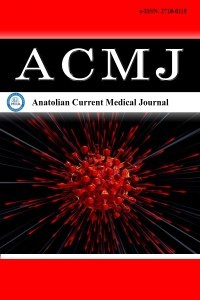1.
Sayıner A, Azap A, Yalçı A, et al. Türk toraks derneği erişkinlerde toplumda gelişen pnömoniler tanı ve tedavi uzlaşı raporu. 2021.
2.
Wunderink RG. Community-acquired pneumonia.infectious diseases (Fourth Edition).<em> Neth J Med. </em>2017;1:251-257.
3.
Ramirez JA, Wiemken TL, Peyrani P, et al. Adults hospitalized with pneumonia in the united states: incidence, epidemiology, and mortality. <em>Clin Infect Dis</em>. 2017;65(11):1806-1812.
4.
Shoar S, Musher DM. Etiology of community-acquired pneumonia in adults: a systematic review. <em>Pneumonia</em>. 2020;12:11.
5.
Özlü T, Bülbül Y, Özsu S. Ulusal Verilerle Toplumda gelis¸en pnömoniler. <em>Tüberk Toraks Derg.</em> 2007;55:191-212.
6.
Brown JS. Community-acquired pneumonia. <em>Clinical Medicine</em>. 2012;12(6):538-543.
7.
Baskaran, V, Murray RL, Hunter A, et al. Effect of tobacco smoking on the risk of developing community acquired pneumonia: A systematic review and meta-analysis. <em>PloSone</em>.2019;14(7):0220204.
8.
McLaughlin JM, Khan FL, Thoburn EA, et al. Rates of hospitalization for community-acquired pneumonia among US adults: a systematic review. <em>Vaccine</em>. 2020;38(4):741-751.
9.
Aliberti S, Cruz CSD, Amati F, et al. Community-acquired pneumonia.<em>Lancet</em>. 2021;398(10303):906-919.
10.
Houck PM, Bratzler DW, Nsa W, et al. Timing of antibiotic administration and outcomes for Medicare patients hospitalized with community-acquired pneumonia. <em>Arch Intern Med. </em>2004; 164:637-644.
11.
Cesur S. Covid-19 pandemisi döneminde tan<span dir="RTL">ı </span>konan bir toplum kaynakl<span dir="RTL">ı </span>pnömonisi olgusu<span dir="RTL">. </span><em>Tüberk Toraks Derg</em><em><span dir="RTL">. </span></em><span dir="RTL">2021;1:116-119.</span>
12.
Gao J,Chu W,Duan J,et al. Six-month outcomes of post-ARDS pulmonary fibrosis in patients with H1N1 pneumonia.<em> Front Mol Biosci</em><span dir="RTL">. 2021</span>;8:640763.
13.
Huang WJ, Tang XX. Virus infection induced pulmonary fibrosis. <em>J Trans Med.</em> 2021;19(1):496.
14.
Sheng G, Chen P, Wei Y, et al. Viral infection increases the risk of idiopathic pulmonary fibrosis: a meta-analysis<em>.Chest</em><span dir="RTL">. </span>2020;157;1175-1187.
15.
Richter AG, Stockley RA, Harper L, Thickett DR. Pulmonary infection in wegener granulomatosis and idiopathic pulmonary fibrosis.<em>Thorax</em>.2009;64(8):692-697.
16.
Molyneaux PL, Maher TM. The role of infection in the pathogenesis of idiopathic pulmonary fibrosis.<em> Eur Respir Rev</em>. 2013;22:376-381.
17.
Raghu G, Collard HR, Egan JJ, et al. An official ats/ers/ jrs/alat statement: idiopathic pulmonary fibrosis: evidence-based guidelines for diagnosis and management. <em>Am J Respir Crit Care Med.</em> 2011;183:788-824.
18.
File TM. Community-acquired pneumonia. <em>Lancet.</em><span dir="RTL"> 2003</span>; 362: 1991-2001. doi: 10.1016/S0140-6736(03)15021-0
19.
Nuorti JC, Farley MM, Harrison LH, et al. Cigarette smoking and invasive pneumococcal disease. <em>N Eng J Med</em>.<span dir="RTL">2000</span>;342:681-689.
20.
Wilson MS, Wynn TA. Pulmonary fibrosis: pathogenesis, etiology and regulation. <em>Mucosal Immunol</em>.<span dir="RTL">2009</span>;2:103-121.
21.
Molyneaux PL, Cox MJ, Saffron AG, et al. The role of bacteria in the pathogenesis and progression of idiopathic pulmonary fibrosis.<em>Am J Respir Crit Care Med</em>.<span dir="RTL">2014</span>;190:906-913.
22.
Selman M, Buendia-Roldan I, Pardo A. Aging and pulmonary fibrosis.<em> Rev Invest Clin</em>. 2016;68(2):75-83.
23.
Pardo A, Selman M. Lung fibroblasts, aging, and idiopathic pulmonary fibrosis.<em>Ann Am Thorac Soc</em>. 2016;13:417-421.
24.
Leung J, Cho Y, Lockey RF, Kolliputi N. The role of aging in idiopathic pulmonary fibrosis. <em>Lung.</em> 2015;193(4):605-610.
25.
Stout-Delgado HW, Cho SJ, Chu SG, et al. Age-dependent susceptibility to pulmonary fibrosis is associated with NLRP3 inflammasome activation.<em>Am J Respir Cell Mol Biol</em>.2016;55:252-263.
26.
Lopez Ramirez C, Valdivia LS, Portal JAR. Causes of pulmonary fibrosis in the elderly. <em>Med Sci</em>. 2018;6:58.
27.
OhCK,MurrayLA,MolfinoNA.Smoking and idiopathic pulmonary fibrosis.<em>Pulm Med.</em>2012;20:808260.
28.
BellouV,BelbasisL,EvangelouE.Tobacco smoking and risk for pulmonary fibrosis: a prospective cohort study from the UK Biobank.<em>Chest</em><span dir="RTL">. </span>2021;160:983-993.
29.
Park Y, Ahn C, Kim TH. Occupational and environmental risk factors of idiopathic pulmonary fibrosis: a systematic review and meta-analyses. <em>Sci Rep</em>. 2021;11:43182021.
30.
Sousa C, Rodrigues M, Carvalho A, et al. Diffuse smoking-related lung diseases: insights from a radiologic-pathologic correlation.<em>Insights Imaging</em>.2019;10:73.

